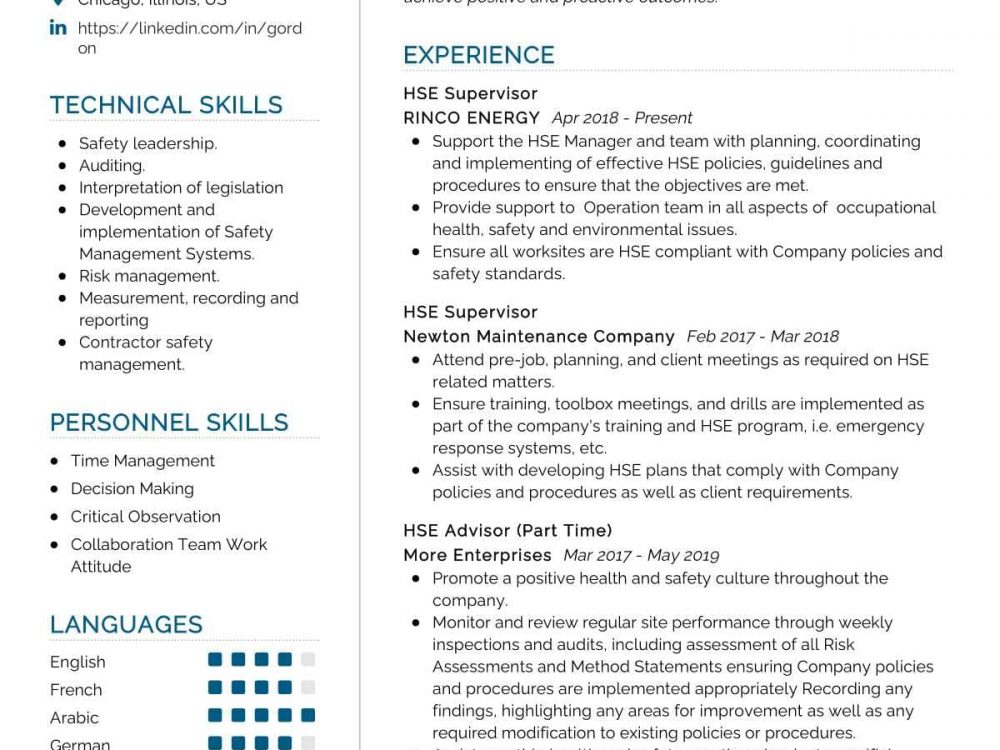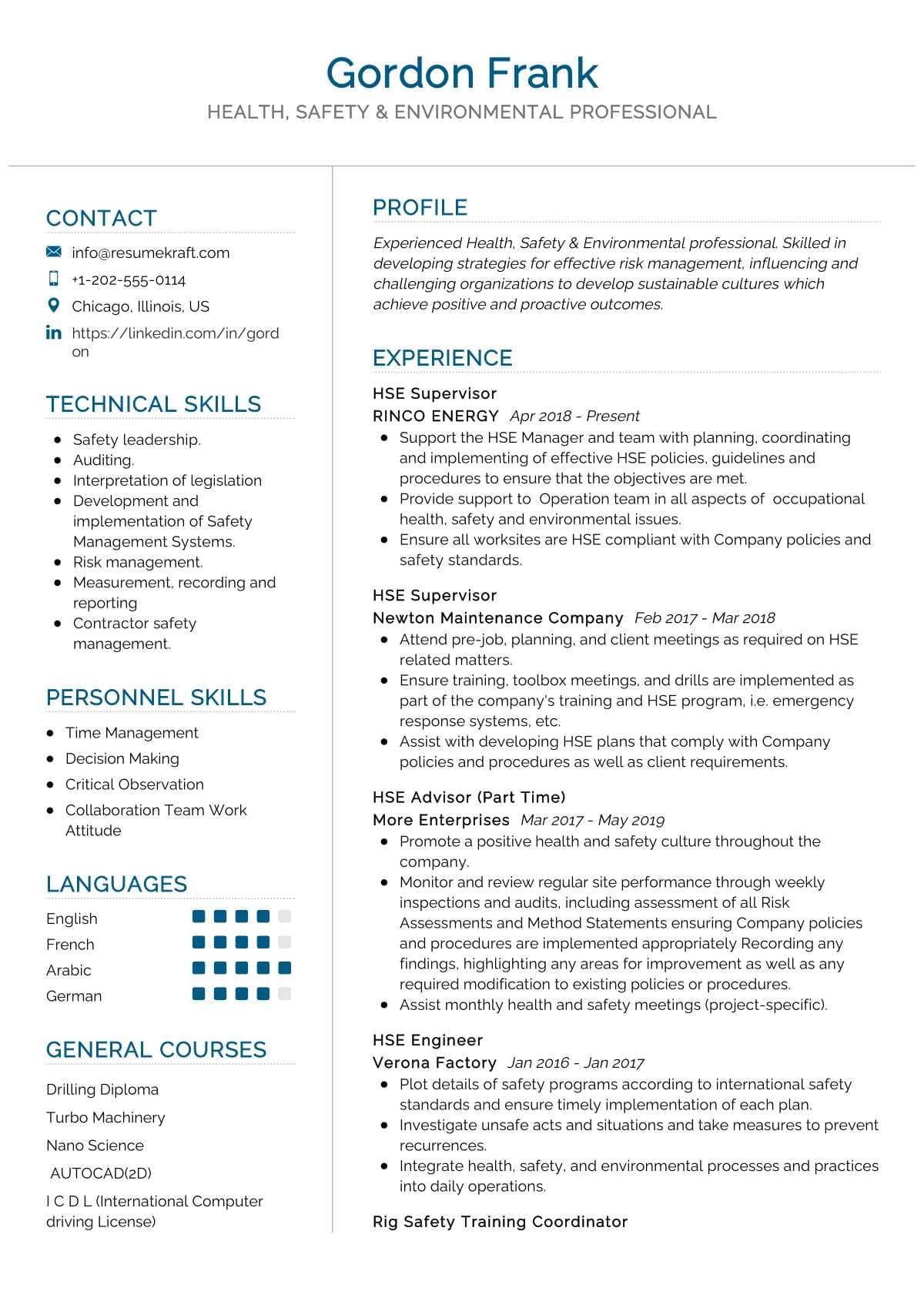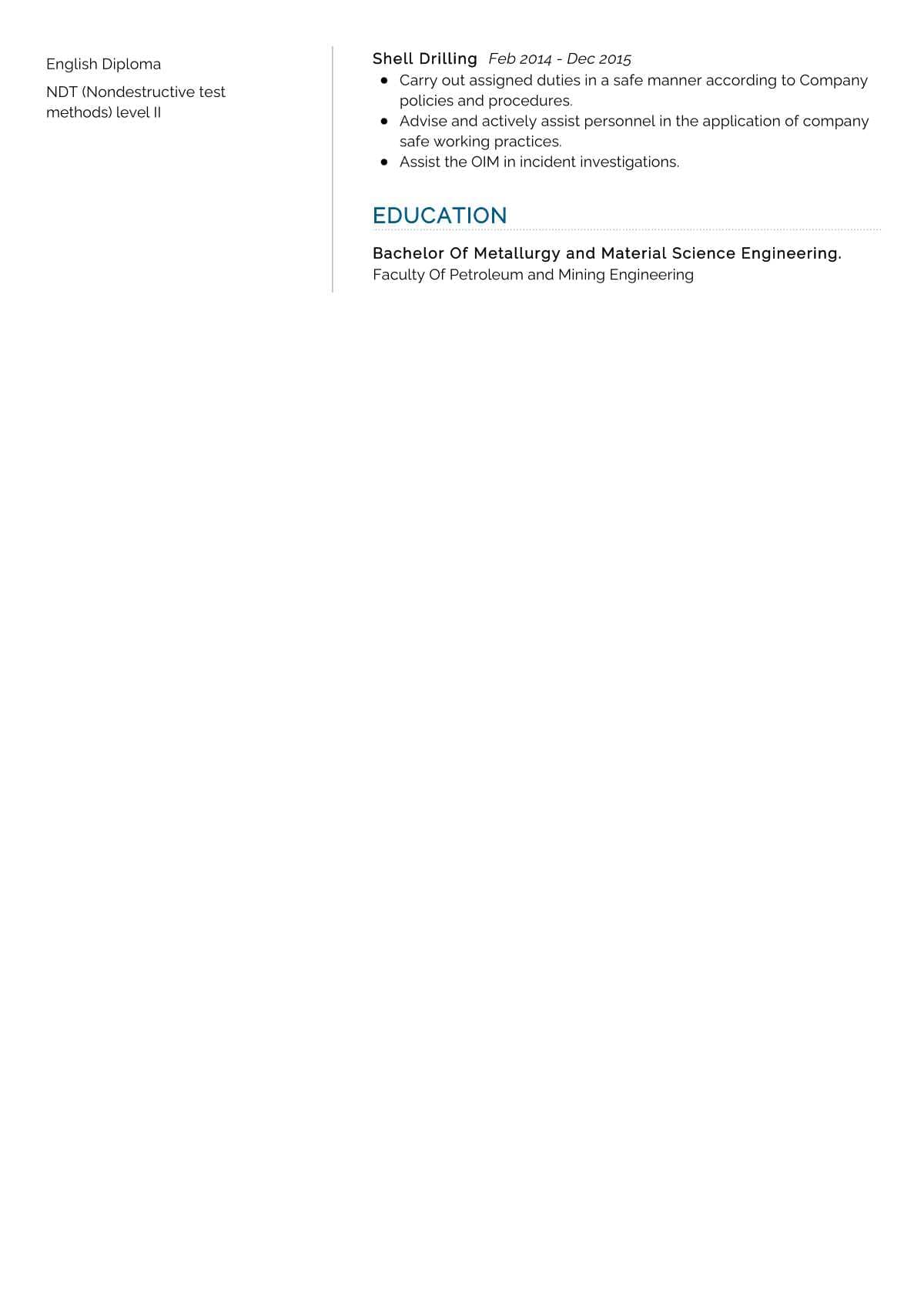Are you a Health Safety Environment by profession and looking for an exciting career? We have good news for you! use our professional Health Safety Environment Resume Sample. You don’t have to start writing from scratch. Just click “Edit Resume” and modify it with your details. Update the template fonts and colors have the best chance of landing your dream job. Find more resume samples.
Health Safety Environment Resume Sample
Gordon Frank
Health, Safety & Environmental professional
Summary
Experienced Health, Safety & Environmental professional. Skilled in developing strategies for effective risk management, influencing and challenging organizations to develop sustainable cultures which achieve positive and proactive outcomes.
Skills
- Safety leadership.
- Auditing.
- Interpretation of legislation
- Development and implementation of Safety Management Systems.
- Risk management.
- Measurement, recording and reporting
- Contractor safety management.
Work Experience
HSE Supervisor
RINCO ENERGY
- Support the HSE Manager and team with planning, coordinating and implementing of effective HSE policies, guidelines and procedures to ensure that the objectives are met.
- Provide support to Operation team in all aspects of occupational health, safety and environmental issues.
- Ensure all worksites are HSE compliant with Company policies and safety standards.
HSE Supervisor
Newton Maintenance Company
- Attend pre-job, planning, and client meetings as required on HSE related matters.
- Ensure training, toolbox meetings, and drills are implemented as part of the company’s training and HSE program, i.e. emergency response systems, etc.
- Assist with developing HSE plans that comply with Company policies and procedures as well as client requirements.
HSE Advisor (Part Time)
More Enterprises
- Promote a positive health and safety culture throughout the company.
- Monitor and review regular site performance through weekly inspections and audits, including assessment of all Risk Assessments and Method Statements ensuring Company policies and procedures are implemented appropriately Recording any findings, highlighting any areas for improvement as well as any required modification to existing policies or procedures.
- Assist monthly health and safety meetings (project-specific).
HSE Engineer
Verona Factory
- Plot details of safety programs according to international safety standards and ensure timely implementation of each plan.
- Investigate unsafe acts and situations and take measures to prevent recurrences.
- Integrate health, safety, and environmental processes and practices into daily operations.
Rig Safety Training Coordinator
Shell Drilling
- Carry out assigned duties in a safe manner according to Company policies and procedures.
- Advise and actively assist personnel in the application of company safe working practices.
- Assist the OIM in incident investigations.
Education
Bachelor Of Metallurgy and Material Science Engineering
Faculty Of Petroleum and Mining Engineering
Languages
- French
- English
- German
- Chines
Career Expert Tips:
- Always make sure you choose the perfect resume format to suit your professional experience.
- Ensure that you know how to write a resume in a way that highlights your competencies.
- Check the expert curated popular good CV and resume examples
Health Safety Environment Resume Writing Guide & Tips
Are you applying for a career in the healthcare industry and need help with your resume? Consider using our Health Safety Environment Resume Writing Guide & Tips to make sure you nail it the first time. With a guide to customizing your resume and tips from industry professionals, you can showcase your skills and experience in a way that will get you noticed.
Health Safety Environment Resume Writing Guide & Tips:
A resume is an important first step in searching for employment. Keep these tips in mind as you prepare your resume to make sure it’s up to snuff for whatever job it may attract.
- Use a professional font that is easy to read, such as Arial, Tahoma, or Times New Roman. Avoid novelty fonts such as Comic Sans or Papyrus; they can be difficult for an employer to decipher and indicative of someone who is not serious about the position.
- Keep the resume as concise as possible. Employers want to see your skills, not your life history. Limit each section to no more than one page of information.
- Describe relevant experiences in the most concise way possible. For instance, if you teach English in a foreign country for two years, describe that experience in its most basic terms. Use bullets and keep it short: “Teaching English in China” rather than “Ten years teaching English in China. Employed for four years in Beijing.”
- If possible, include names and titles of employers and organizations where you have worked. For instance, if you are a writer, list past publications. If you worked at a corporation for three years, list the name of the corporation in all subsequent job searches. You never know when this material might come in handy during any interview.
- Use current professional terminology in your resume whenever possible. For instance, if you worked in a Japanese Department Store for two years, you might describe that experience as “Marketing Director in Japanese Department Store” instead of “Assistant Manager at the Sushi Bar & Toy Shop.”
- If you are not sure what to include in a particular section of the resume, leave it out. That information will be apparent to the employer during the interview process.
- No matter how well you write or how long you’ve been working in an industry, if your resume does not immediately attract attention, it probably won’t land you an interview. That being said, assume that no one reads a resume before interviewing candidates. Obviously, this is not always true, but keep this point in mind. It will help you focus on what is most important.
- Keep in mind that each employer has a different idea of what they are looking for in a candidate. Even if you cannot find recent job postings that list the exact requirements for jobs, look at similar ones and mimic their requirements. There is no harm in doing this as long as you can prove your worth to an employer.
List of Typical Responsibilities For a Health Safety Environment Resume:
- Kills hazards by enforcing rules and regulations.
- Regulates employee exposure to ergonomic and safety hazards.
- Develops and monitors programs that improve worker health.
- Manages workers’ compensation claim management systems.
- Supervises and works directly with employees on tasks related to safety, health, security, environment, or industrial relations.
- Completes regular inspections of equipment to ensure safe operation.
- Ensures that all occupational safety and health elements are implemented and enforced to meet the organizational mission.
- Monitors control to detect violations of OSHA, state, federal or local laws.
- Maintains awareness of health and safety issues through regular meetings with representatives from other departments or agencies, consults on health and safety policies and procedures, provides technical assistance for new technologies, regulatory changes, legal requirements, or processes needed to improve employee health and safety.
Top 15 Must-have Health Safety Environment Skills:
- Ability to research and interpret information from various sources
- Ability to communicate effectively in English
- Ability to work and interact well with others
- Excellent computer skills
- Planning and organization skills
- Good memory skills and information retention capability
- Positive attitude and approach toward work matters and people
- Quick decision making skill without compromising quality of work
- Good presentation skills with strong communication capabilities
- Ability to prioritize work tasks in a realistic and effective manner
- Problem-solving skills
- Working under pressure and deadlines – ability to work with minimum supervision
- Knowledge of computers, software, and hardware systems
- Good performance in stress situations and crisis management
- Flexibility and adaptability to change situation or environment
Tips to write a Health Safety Environment Resume Summary:
Gather all your work, references, and education and add them to your resume. It doesn’t matter if it’s been five years since you applied for a job, you’re going to need that information.
A summary is a quick way to summarize your skills in one place. For example, in your email signature or on social media sites like LinkedIn or Facebook, use the #healthsafetyresume hashtag when writing a summary of what makes you an excellent candidate for this position.
Your resume should be neat and easy to read. Avoid arcane fonts, strange layouts, and extravagant colors. The plain white paper is the best background for your resume as it’s easily printed on any printer. Black ink is the best for screened text as it doesn’t show through on copiers.
Avoid using capital letters except in headings. Capitalization cannot be read by optical character recognition programs used by some companies for job applications.
How to write a Health Safety Environment Resume with No experience:
- Make sure you have a resume and cover letter on hand.
- Begin by stating your job objective clearly.
- List your education, training, certifications, and skills first.
- List your work experience (if any) last as it relates to the position you are applying for.
- You can also add personality traits in the form of “I am a person who likes to…” or “The most important thing for me at work is…”, etc..
- Go over each resume and cover letter sentence by sentence.
- Rewrite each section until it is perfect.
- Get some help from someone else if you need to.
- Make sure your resume does not rely on you having a degree, certification or qualification.
- You can state simply “Previous education” or “Skills” instead of stating “Graduated with honors”. Keep it short and sweet.
How to write a Health Safety Environment Cover Letter:
- Begin with a greeting.
- Follow with an introductory paragraph or paragraph introductions:
- Summarize your experience, skills, and career goals in the body of the letter:
- End with a closing paragraph and sign off:
“Sincerely,” Sincerely Yours,” or”Best Regards,” followed by your name. - Don’t forget to write the address of the organization, date it, “sign” it, and attach your resume. Make sure that you also include a contact number where you can be reached for additional information or clarifications.
- Use language specific to the reader’s company (i.e. ‘we’ instead of ‘you’) and avoid terms like “Per your request” (because it might be the first time he has heard from you).
- Avoid excessive use of acronyms, jargon, or slang; be professional.
- Proofread before sending, since editing is easier before you hit ‘send.’
- Use a word processing program that allows you to create, correct, and edit your letter in sections so that mistakes can be easily identified and corrected without having to retype the entire document.
Key Takeaways:
- Do not move from one construction job to another – do not leave a good job for a worse one.
- Do not be too shy to ask work for references – You can easily get free references from your previous employers, even when you are working for other companies so that you can write your resume.
- Make sure to include the most important skills and experience in your resume and highlight them.
- Be sure that your resume is addressed properly as well as it is addressed to the right person.



